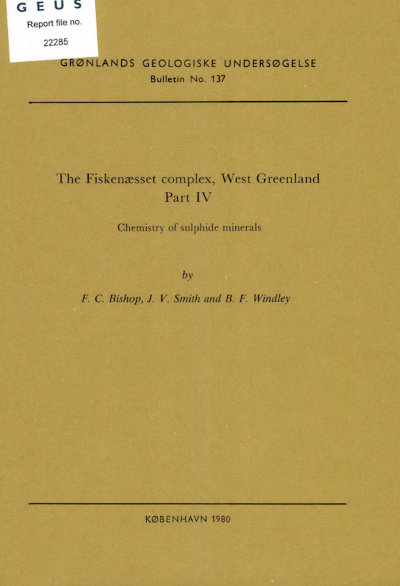The Fiskenæsset complex, West Greenland. Part IV. Chemistry of sulphide minerals
DOI:
https://doi.org/10.34194/bullggu.v137.6679Abstract
The textures and chemistry of sulphides were investigated in 63 rocks from the Fiskenæsset complex, West Greenland, by light microscopy, electron microprobe, and X-ray diffraction techniques. Sulphides are found disseminated throughout the layered sequence, being especially concentrated in the ultramafic zone and in ultramafic lenses in the higher zones. Sulphide phases are restricted to the Cu-Fe-Ni-Co-S system – pentlandite, pyrrhotite, chalcopyrite, pyrite, millerite, heazlewoodite, cobalt-pentlandite, polydymite, godlevskite, violarite, cubanite, and digenite. Most sulphides occur interstitially as rounded globules often containing significant quantities of oxides. Some aggregates occur as inclusions in silicate or chromite, as ragged stringers between other phases, or with scalloped intercumulus textures. Subsolidus reactions are common; fine-scale intergrowths of pentlandite-pyrite, chalcopyrite-pyrite, chalcopyrite-cubanite, pentlandite-heazlewoodite and pentlandite-godlevskite-polydymite occur. Euhedral pyrite is found in the anorthosites and chromitites. Pyrite-millerite appears to be an equilibrium pair in some rocks. Weathering affects the major phases in the following order: pyrrhotite > chalcopyrite > pentlandite. Temperature stability limits for several of the phases, equilibrium phase assemblages, and textures of the sulphide intergrowths, all indicate that the sulphides have re-equilibrated to low temperatures. The common pyrite-pentlandite assemblage places a 230°C upper limit, and the digenite composition places a 125°C lower limit, on the temperature of equilibration. A marked sulphide stratigraphy which correlates with silicate chemistry is present in the Fiskenæsset complex. There is a systematic progression from Ni,Fe-rich sulphides in the lower ultramafic and mafic zones to Cu,S-rich assemblages in the upper, more felsic zones. Sulphide fractionation exhibiting some of these features is also found in other layered igneous intrusions. The similarity of the Fiskenæsset sulphides with those in other intrusions, coupled with the unlikely possibility of derivation of the sulphides by assimilation or metasomatism, implies that the sulphides were derived from the original magma.
Downloads
Published
Issue
Section
License
This article is distributed under a CC-BY 4.0 licence, permitting free redistribution and reproduction for any purpose, even commercial, provided proper citation of the original work. Author(s) retain copyright over the article contents.


